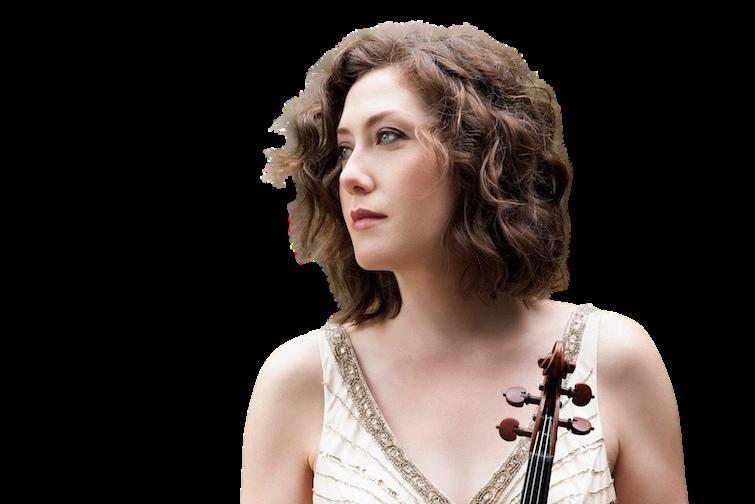

Scheherazade
October 3 | 7:30PM
October 5 | 3PM

Masterworks 2
Three Nocturnes (1897-99)
by Claude Debussy (Saint-Germain-en-Laye, nr. Paris, 1862 - Paris, 1918)
Written between the Prelude to the Afternoon of a Faun and La Mer, the Three Nocturnes represent an important milestone in Debussy’s evolution as a composer, as well as in the evolution of what has been called musical “impressionism.” The use of this term, borrowed from the visual arts, is as problematic as it is unavoidable: problematic because Debussy emphatically rejected it, but unavoidable since–with a hindsight of more than a century–we can’t help but see certain parallels between Debussy’s music and the impressionist painters of his time. Debussy rebelled against his academic predecessors (Gounod, SaintSaëns, Massenet) in much the same way his artist contemporaries (Degas, Renoir, Monet) rebelled against their own elders of the realist school (Corot, Courbet, Bouguereau). The similarity is striking in spite of the fact that in painting, the “rebellion” started considerably sooner than in music.
There is no denying that Debussy loved painting, and often associated musical sounds with colors and images. Speaking of the Three Nocturnes, he even said that they were meant to designate “all the various impressions [my emphasis, P. L.] and the special effects of light that the word suggests.” And even the title Nocturne has less to do with the piano pieces of Chopin than with the paintings of James McNeill Whistler (1834-1903). The American-born, London-based Whistler called several of his works “Nocturnes,” and these are often night scenes, depicting, for instance, the river Thames or the lagoon of Venice
Debussy was fond of tripartite structures all his life; many of his works–for instance the orchestral and piano Images or La Mer–are in three movements. The three nocturnes–in turn contemplative, celebratory and sensual–form a triptych in which the composer responds in turn to nature, people, and the world of the imagination. Two earlier works, considered to be predecessors of the Nocturnes, have not survived: a composition called Scènes au crépuscule (“Twilight Scenes”) and a planned violin concerto for Eugène Ysaÿe, of which at least a few sketches exist. The composition as we know it today was written between 1897 and 1899.
Since the third nocturne (“Sirènes”) requires a women’s chorus, unavailable at the first performance, only the first two movements were played at the premiere on December 9, 1900. The complete work was heard the first time on October 27, 1901 On both occasions, Camille Chevillard was leading the Lamoureux Orchestra in Paris.
Masterworks 2
Debussy said that the first movement, “Nuages” (“Clouds”), evokes a moment when he was standing on the Solférino Bridge in Paris late at night, watching the clouds in the sky.
Nuages renders the immutable aspect of the sky and the slow and solemn motion of the clouds, fading away in grey tones lightly tinged with white.
The clarinets and bassoons intone a haunting melody made up of the multiple repeats of a single, delicately harmonized phrase. The English horn adds a meditative counter-theme, and the French horns follow suit with a single, wonderfully expressive pair of notes. Out of this rather modest raw material, Debussy fashioned a magical movement, full of mystery and enchantment.
“Fêtes” (“Festivities”) takes us to the Bois de Boulogne, the vast wooded park on the western edge of the French capital, where various celebrations were held, from family outings to military processions. Debussy imagined, or remembered,
A retreat with torches, evening in the woods….I have seen from afar, through the trees, lights approaching, and the crowd running towards the path where the procession is going to pass. Then…the horsemen of the Garde Républicaine, resplendent, their arms and helmets lit by the torches, and the bugles sounding their fanfare. At last, all that fades and grows distant.
The movement is in ABA form where the “A” section represents the spectators in the park and the “B” the horsemen passing through. The opening melody has been compared to an Italian tarantella dance, but several commentators have also detected an influence of Russian music. The joyful strain of themes is suddenly interrupted by the arrival of the Republican Guard. Against a rhythmic accompaniment, three muted trumpets announce the gendarmes. Their memorable theme gets louder and louder as they gradually approach. The return of the “A” section is enriched by an expressive new melody, combined with recalls of the march music. The guard moves on and the crowd gradually disperses as a gentle new theme is introduced by the woodwind.
“Sirènes” (“Sirens”) evokes the famous seductresses from Homer’s Odyssey who beguile Odysseus with their alluring voices. The image inspired some of Debussy’s most intensely sensual moments. The wordless female chorus blends in perfectly with the orchestra, where the English horn is, once again, featured prominently. (The main melody is very close to the lyrical theme in “Dialog of the Wind and the Sea,” the last movement of La mer.) The enchanting song becomes more and more intense, before calming down and fading into silence.
Masterworks 2
Vers toi qui es si loin (“To You Who Are So Far,” 2017)
by Kaija Saariaho (Helsinki, 1952 - Paris, 2023)
Kaija Saariaho’s L’amour de loin (“Love from Afar,” 2000) was one of the great operatic sensations of recent decades Twenty-five years after its premiere at the Salzburg Festival, it has truly become a modern classic, performed at all major musical centers of the world. A quintessentially Romantic story from the Middle Ages, told in a modern style, the Finnish composer’s first opera (she later composed four more) is one of those works one can never forget even after a single hearing.
Based on a libretto by Lebanese-French writer Amin Maalouf, the opera recounts the life of the 12th-century troubadour Jaufré Rudel According the medieval story, Jaufré, a prince and a poet from Blaye in southwestern France, fell in love with the Countess of Tripoli, having heard of her beauty and her virtue from pilgrims who had travelled the seas. He embarked on a long voyage to rejoin his beloved, but was taken ill on the ship and, arriving in Tripoli (in present-day Lebanon), died in the arms of the Countess.
The opera combines spirituality and sensuality, and features some highly expressive vocal writing and an extremely colorful, shimmering orchestration Its extraordinary success prompted Saariaho to draw on the music for shorter works intended for concert performance. Thus, in 2001, she wrote Cinq reflets de L’Amour de Loin (“Five Reflections from Love from Afar”), a 30-minute suite for soprano, baritone and orchestra. Many years later, she composed the present work for solo violin, piccolo, harp and strings, where she rescored the opera’s concluding scene, replacing the soprano voice by the violin. At this moment following the death of Jaufré, Countess Clémence, who has decided to spend the rest of her life in a convent, embraces “love from afar” as a transcendent feeling where her love for the troubadour and her love for God become one.
Vers toi qui es si loin was written for Norwegian violinist Peter Herresthal. In spite of the reduced orchestration, Saariaho was able to preserve the rich sound world of the original. Transferring the vocal line to the violin, she took full advantage of the instrument’s stratospheric high register.
Masterworks 2
Scheherazade
Symphonic Suite after The Thousand-and-One Nights, Op. 35 (1888)
by Nikolai
Rimsky-Korsakov (Tikhvin, Russia, 1844 – Lyubensk, nr. St. Petersburg, 1908)
The ancient tales of Ali Baba and the Forty Thieves, the Spirit in the Bottle, and so many others have delighted many generations of readers throughout the world. When The Thousand-and-One Nights was first translated from Arabic into a European language (French) in the 18th century, Western readers were introduced to the fascinating world half-real and half-imaginary of an Orient about which they could have very little first-hand information at the time.
Nikolai Rimsky-Korsakov, for one, did know Arabia from personal experience. As a young officer in the Russian Navy during the 1860s, he toured the Mediterranean region–as well as many other parts of the world–for two and a half years About 25 years later, in 1888, he wrote Scheherazade, in which he strove to capture the general atmosphere of the Oriental fairy-tale collection. The former seaman was naturally drawn to the stories involving Sindbad the sailor, and included several sea stories in his original outline to the work, as seen from the descriptive titles which he planned to provide for the individual movements:
The Sea and Sindbad’s Ship
The Story of the Kalandar Prince
The Young Prince and the Young Princess
Festival at Baghdad – The Sea – The Ship Goes to Pieces on a Rock Surmounted by a Bronze Warrior – Conclusion
In the end, the composer decided to omit these titles from the printed score. He preferred to think of the work as “an orchestral suite in four movements, closely linked by the community of its themes and motifs, yet presenting, as it were, a kaleidoscope of fairy-tale images and designs of Oriental character.” Rather than re-telling the stories in music, Rimsky-Korsakov wanted to evoke their general flavor and to give musical form to a Westerner’s dream about the magical Orient.
Masterworks 2
The many stories of The Thousand-and-One Nights are framed by the main story about Sultan Shahriar and his wife Scheherazade. Here is how Rimsky-Korsakov summed it up in his preface to the score:
The Sultan Shahriar, convinced of the falsehood and inconstancy of all women, had sworn an oath to put to death each of his wives after the first night. However, the Sultana Scheherazade saved her life by arousing his interest in the tales which she told during the 1001 nights. Driven by curiosity, the Sultan postponed her execution day to day and at last abandoned his sanguinary design
Day by day, to put off her own execution, Scheherazade told miraculous stories to the Sultan. For her tales she borrowed verses from classic poets and words from ancient folksongs, creating an exciting combination of fairy-tale and adventure that the monarch found impossible to resist.
Rimsky-Korsakov’s “community of themes and motifs” means that, although the four movements are strongly contrasted in tempo and character, two main motifs are heard over and over again throughout the piece. They are subjected to many variations that change the rhythm and the orchestration but the basic melody always remains the same. The first of these two motifs is announced at the very beginning of the piece by the strings in unison, the second immediately afterwards by the solo violin (which will play a prominent role in all four movements). The themes represent the two protagonists, Sultan Shahriar and Scheherazade, respectively. Thus, throughout the episodes, we are constantly reminded of the basic setting, with Scheherazade speaking and Shahriar listening.
The brilliance of Rimsky-Korsakov’s melodic imagination is matched by his mastery of orchestration. It wasn’t for nothing that his reputation rested in part on his superb handling of the symphony orchestra. (He wrote a classic textbook on the subject.) In addition to the prominent violin solo, he gave important solo turns to the cello, the flute, the oboe, the clarinet, the bassoon, the trumpet, and the harp, carefully choosing the specific tone colors to achieve the intended effect. The various instruments blend in novel ways that influenced many composers of the subsequent generation, not least Rimsky-Korsakov’s most famous pupil, Igor Stravinsky.
Notes by Peter Laki
